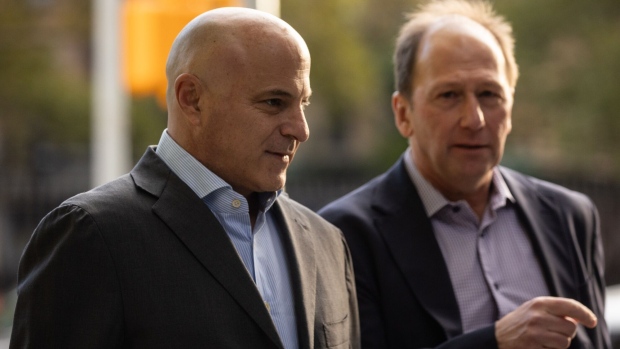Oct 17, 2023
Glen Point Trial Reveals Morgan Stanley Tried To Buy Back Option
, Bloomberg News

(Bloomberg) -- A week before Glen Point Capital co-founder Neil Phillips allegedly manipulated the foreign exchange markets to trigger a $20 million option, Morgan Stanley offered to buy the option back for $13 million, a witness testified on the first day of the former hedge fund executive’s fraud trial.
Graeme Henderson, a London-based foreign exchange broker with JB Drax, was the first witness called to the stand Tuesday by Manhattan federal prosecutors. Drax was the intermediary through which Glen Point in October 2017 bought the option pegged to a “barrier” exchange rate between the South African rand and the US dollar from Morgan Stanley for around $2 million.
Under questioning by the defense, Henderson said that Morgan Stanley offered to buy back the option on Dec. 18, 2017, starting with an offer of $9 million. Three hours later, the bank said it was willing to pay $13 million. Glen Point declined both offers, Henderson testified.
Prosecutors claim that the $725 million in trades Phillips directed on Dec. 26, 2017, were market manipulation aimed at triggering the $20 million option at the barrier rate of 12.50 rand against the dollar. A guilty verdict for Phillips could have a chilling effect on the trading practice known as barrier chasing or defending.
The broker’s testimony that the bank was eager to unwind the option, even at a steep loss, potentially bolsters the defense argument that Phillips had a lawful trading strategy to which he was committed and which his counterparty and alleged victim, Morgan Stanley, anticipated. Phillips’s lawyers have said they plan to show barrier trading is standard industry practices and that the bank itself engaged in a barrier defense.
Read More: Glen Point Trial Casts Morgan Stanley as Hedge Fund’s Victim
Henderson testified that banks often actively trade as currencies approach option barriers. “They’re going to reduce the risk of them not being hedged,” he said. “There’s a lot of increased hedging activity as the barrier gets closer.”
In opening statements earlier on Tuesday, Assistant US Attorney Kiersten Ann Fletcher likened the option to a 10-to-one bet placed by Phillips.
“If he got it right and his bet paid off, he stood to make $20 million,” Fletcher told the jury. But when “it looked like the market wasn’t going the way he thought it would he didn’t just accept his losses and walk away. No. He cheated. He made the market move his way. In the middle of the night on Christmas this man took the markets into his own hands.”
Phillips’s lawyer, Jenna Dabbs, told the jury that his moves were completely lawful and permissible and instead reflected his skill and prescience in the market.
“It was precisely the trading you would expect from somebody with experience as an investor and trader,” Dabbs said.
Morgan Stanley’s offer to buy back the option coincided with Cyril Ramaphosa’s victory in the African National Congress election, virtually guaranteeing he would win South Africa’s national election. Phillips has argued that his strategy was based on a bet that Ramaphosa’s win would cause the rand to rise.
PE Partner Juror
The jury that’s hearing the case likely varies in its familiarity with Wall Street and finance, though one juror is a partner at a private equity firm. The nine women and three men also include a home health care aide, a Sunday school teacher, and a purveyor of cotton candy.
Prosecutors are expected to call witnesses from a number of financial institutions, including Morgan Stanley. But US District Judge Lewis Liman on Monday blocked direct testimony by three proposed government witnesses from Goldman Sachs Group Inc., Barclays Plc and Bank of America Corp. The proposed witnesses weren’t identified, but prosecutors said they worked at the bank in a compliance function.
In a conference with Liman, defense lawyer Sean Hecker said those witnesses lacked relevant experience.
“None of these witnesses, to my understanding, are going to be traders who were in the market at the time and could testify as to their reasonable expectations,” Hecker said. He compared compliance witnesses to having a police officer testify about the speed limit on the Brooklyn-Queens Expressway.
“It actually doesn’t tell you whether people are speeding or reasonably expecting people to speed,” he said.
The case is US v. Phillips, 22-cr-138, US District Court, Southern District of New York (Manhattan).
--With assistance from Greg Farrell.
©2023 Bloomberg L.P.






